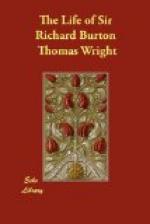[FN#388] Early Ideas by an Aryan, 1881. Alluded to by Burton in A. N., Lib. Ed., ix., 209, note.
[FN#389] Persian Portraits, 1887. “My friend Arbuthnot’s pleasant booklet, Persian Portraits,” A. N. Lib. Ed. x., 190.
[FN#390] Arabic Authors, 1890.
[FN#391] In Kalidasa’s Megha Duta he is referred to as riding on a peacock.
[FN#392] Sir William Jones. The Gopia correspond with the Roman Muses.
[FN#393] The reader will recall Mr. Andrew Lang’s witty remark in the preface to his edition of the Arabian Nights.
[FN#394] Kalyana Mull.
[FN#395] The hand of Burton betrays itself every here and there. Thus in Part 3 of the former we are referred to his Vikram and the Vampire for a note respecting the Gandharva-vivaha form of marriage. See Memorial Edition, p. 21.
[FN#396] This goddess is adored as the patroness of the fine arts. See “A Hymn to Sereswaty,” Poetical Works of Sir William Jones, Vol. ii., p. 123; also The Hindoo Pantheon, by Major Moor (Edward FitzGerald’s friend).
[FN#397] “Pleasant as nail wounds”—The Megha Duta, by Kalidasa.
[FN#398] A girl married in her infancy.
[FN#399] The Hindu women were in the habit, when their husbands were away, of braiding their hair into a single lock, called Veni, which was not to be unloosed until their return. There is a pretty reference to this custom in Kalidasa’s Megha Duta.
[FN#400] Guy de Maupasant, by Leo Tolstoy.
[FN#401] The Kama Sutra.
[FN#402] Richard Monckton Milnes, born 1809, created a peer 1863, died 1885. His life by T. Wemyss Reid appeared in 1891.
[FN#403] Burton possessed copies of this work in Sanskrit, Mar’athi Guzrati, and Hindustani. He describes the last as “an unpaged 8vo. of 66 pages, including eight pages of most grotesque illustrations.” Burton’s A. N., x., 202; Lib. Ed., viii., 183.
[FN#404] Kullianmull.
[FN#405] Memorial Edition, p. 96.
[FN#406] The book has several times been reprinted. All copies, however, I believe, bear the date 1886. Some bear the imprint “Cosmopoli 1886.”
[FN#407] See Chapter xxxii. It may be remembered also that Burton as good as denied that he translated The Priapeia.
[FN#408] A portion of Miss Costello’s rendering is given in the lovely little volume “Persian Love Songs,” one of the Bibelots issued by Gay and Bird.
[FN#409] Byron calls Sadi the Persian Catullus, Hafiz the Persian Anacreon, Ferdousi the Persian Homer.
[FN#410] Eastwick, p. 13.
[FN#411] Tales from the Arabic.
[FN#412] That is in following the Arabic jingles. Payne’s translation is in reality as true to the text as Burton’s.
[FN#413] By W. A. Clouston, 8vo., Glasgow, 1884. Only 300 copies printed.
[FN#414] Mr. Payne understood Turkish.
[FN#415] Copies now fetch from (pounds)30 to (pounds)40 each. The American reprint, of which we are told 1,000 copies were issued a few years ago, sells for about (pounds)20.




